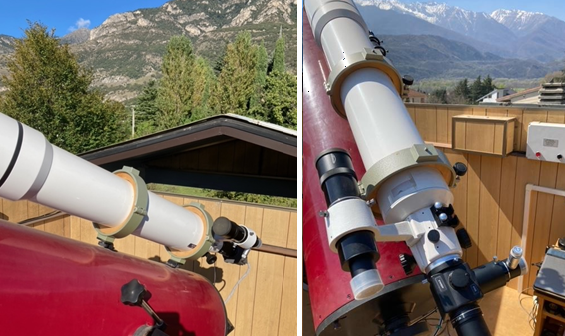
MPC 476 Grange Observatory

The Grange Observatory from 1993 lies atop a private house in Bussoleno (50 km W
from Turin, Italy), in Susa Valley near the French border; Grange comes from the
name of the town's suburb.
The observatory's roll-off roof opens in two parts
and covers a 3 m by 3 m room; the homemade telescope is a 0.3-m Newton/Cassegrain reflector.
The optical instrumentation at Grange Obs. is permanently mounted on a concrete pillar and is
independent from the room's floor; the observing site can be reached via a
foldable ladder from a room devoted to laboratory / library.
The fork mount of the 0.3-m telescope was built at the Turin Observatory workshop with the secondary optics supports; the 10 kg main mirror 9 points cell and the foci common, anti-rotation bronze focuser were built in-house, as well as the support optics tube quest, choosing the Bakelite, a pristine composite material, for thermal isolation and for structural reasons. All the optics were built by Costruzione Ottiche Zen of Venice, and the optics in their supports were precisely integrated on the observatory proprietor's own, being graduated in structural engineering at the time, and hired by a well-known Aerospace Company in Turin in 1989 (now retired). In the '80 in Italy it was absolutely common to (partly or entirely) BUILD a large astronomical telescope.
The telescope
originally had a DOS based EDC 1000 HR camera at 8 bit, then substituted by a SXL8-P CCD camera at 12 bit, peltier cooled, and connected to a 486 DX2 computer with CD-ROM drive, this one
being useful for having a quick access to huge star catalogues and sky surveys
such as GSC-ACT, Tycho 2 and USNO A2.0 . The field given by the camera at the Newton focus was 22x22 square arcmin, being the stars recorded about magnitude 15, reached with 1 minute exposure.
The SXL8-P camera is still mounted at the 0.14-m telescope, used for astrometry and star photometry at f/5.7 through the ASTROART 5 plug-in working with Windows XP on a ASUS laptop having a parallel port. This system can give views of stellar objects in selected photometric wavelengths. A camera QHY6 is present at the 0.3-m a telescope at f/7.75 for IR speckle imaging and astrometry.
The camera SXL8-P has an HR star field of 33x33 arcmin, and it is used for astrometry and for Gaia G photometry.
A flip mirror is also used to mounts eyepieces at the Cassegrain focus of the telescope to point the CCD camera field.
The astrograph's main research activity is stellar photometry, although astrometry is still performed being one of the observatories appointed by IAU past Commission 20 which send their measures to the Central Bureau for
Astronomical Telegrams/Minor Planet Center, located at Smithsonian
Astrophysical Observatory, Cambridge, MA (U.S.A.). Up to date, more than 300 astrometric measures were sent in about 30 years.
Grange Obs. was also one of
the observing sites of the
Gruppo Italiano Astrometristi, the Italian Astrometry Group, which at the time coordinated all the
astrometric activity done in Italy by amateur astronomers, and was a proud member
of Spaceguard
Foundation.
Currently the privately granted MPC 476 Grange Observatory is making researches on fundamental astronomy, such as astrometry and photometry; the instruments of the observatory can measure the distance, the temperature and the spectral class of the stars.
Technical description:
- OBSERVATORY DATA
- Minor Planet
Center code = 476
- Latitude = 45° 08' 31.72" N
- Longitude = 7° 08' 26.68" E
- Height = 480 m Google Earth
- CCD CAMERAS
- A 12-bit Starlight Xpress SXL8-P mono camera
(chip 'frame transfer' Philips FT-12, 512x512, temp. -30°C) mounted on the 0.14-m telescope is mainly used for astrometry and photometry with a field of 33 x 33 arcmin. The camera performs astrometry and has a Gaia G photometric filter.
- A 16-bit camera QHY6, mounted at the 0.3-m Cassegrain focus (f/7.75), has an IR field of 7.2x5.4 square arcmin and a Sloan i filter for speckle imaging and astrometry with a local copy of UCAC 4 star catalogue.
- HOW TO CONTACT GRANGE OBSERVATORY
Go to the AAS
homepage, the local amateur association (in Italian).
Return to Grange Obs. homepage.

